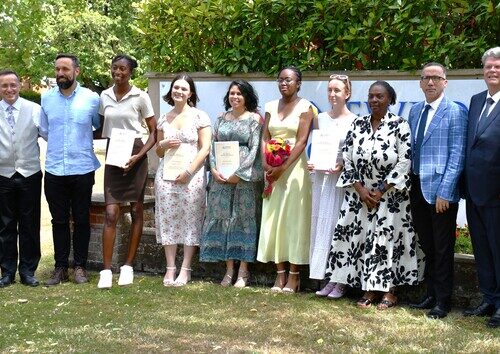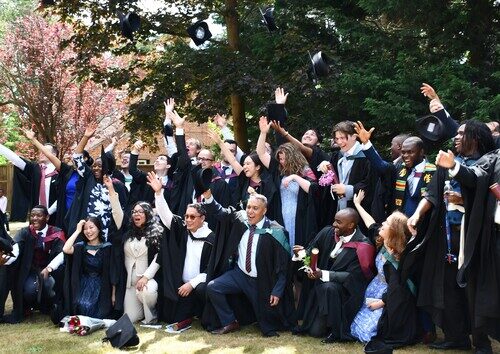31 March 2023 | St. Albans, UK [Daniel Duda & Anthony WagenerSmith]
The third #ENGAGEDinMISSION strategic value of the Trans-European Division (TED) is “Multiply Communities in People Groups and Places.” In both this interview and article, Daniel Duda and Anthony WagenerSmith (TED Mission and Evangelism director) explain the need for the church to purposely look outwards, to extend love to beyond people like us. It is the call of the gospel, calls for sacrifice, takes us out of our comfort zone. What is the distinction between church splitting, church cloning, and church planting?
The Mobile Phone Test
Waking up on a Sunday morning, I remember looking at the contact list on my mobile phone as I was about to call a friend. Scrolling through the names provided a sobering and jarring realization. After my first full year as a pastor, I did not have a single person on my contact list who was a personal friend and also not a believer in Christ. I instantly justified this as I was far too busy encouraging my churches to live on mission to actually do it myself. Yet simultaneously, I sensed the Spirit of God convicting me that I was indeed a “missional hypocrite”. Leading to a time of confession and repentance, that day was a turning point for me. Not only to have a new set of contacts on my mobile phone, but to develop a missional lifestyle that led to the planting of new ministries and churches to reach new people. Who is on your contact list, and what does this reveal about you being personally engaged in mission?
Extending Love and Growing Lifelong Disciples is not Enough
The third strategic focus of the TED is to see every member, leader, church, school, and institution fully engaged in mission. The Seventh-day Adventist Church exists to spread the gospel of Jesus Christ (Matthew 28:18-20) before the return of Christ – to every nation, tribe, language, and people (Acts 1:8; Revelation 14:6-12). And this global mission is why it is not enough to only engage in the first and second strategic focus areas: “Extend Love to the Whole Person”, and “Grow Lifelong Disciple across Generations”.
We can do these well and yet be quite content to stay in the same places and cultural groups that the church is composed of. It is only as we boldly and intentionally multiply communities in new people groups and new places, that the gospel commission will be fulfilled. Through planting new ministries, churches, mission schools, and institutions we create new environments where the first two areas of our strategic focus can also take place. Extending love to the whole person and growing lifelong disciples in a new environment results in multiplied communities. This is God’s vision for exponential growth.
God’s Maths: Addition and Multiplication
Springing up from creation week, every living thing God created has the capacity to multiply. The birds of the air, the fish in the sea, the land animals, and particularly humans, are all designed to increase in number and multiply (Genesis 1:11, 24, 29-30, etc.). We watch in awe as this creative DNA grows exponentially through God’s promise of the physical and spiritual reproduction of Abraham’s descendants, the saving work of Jesus and establishment of his Church, and the promise of a multiplied harvest to the ends of the earth. God’s design was never to have one dad name Adam, one mum named Eve, and over seven billion kids (addition with no multiplication). Rather, his grand story involves kids who become parents and have kids of their own, whose kids in time have their own families as well (addition and multiplication). Churches, just like humans, all have a life cycle of birth, growth, maturity, decline, and death. Therefore, a successful church is more about becoming a mother church – equipping and sending – and less about becoming a mega church – having the biggest crowd around.
Church Splitting, Church Cloning, and Church Planting
Church planting is a primary means through which new communities of believers are established. This is true even for the church you are currently a part of. At some point in the past, somebody or some group of people left where they were, to come to where you are to start something new. It wasn’t a perfect church and they undoubtedly received opposition, but they did it! Speaking from personal experience planting churches and training others through the years – I know how easy it is to minimize future potential because of past circumstances.
Some groups that call themselves church plants are actually “church splits” – groups of people who want church done their way and are driven more by what they are against, than what they are for. Others are “church clones” – importing the exact methods and traditions that worked in a different city or country, without a prayerful and intentional approach to contextualize the gospel to their local community. Rather than church splitting or church cloning, church planting starts with God’s heart for lost people, discerning needs and developing teams to reach and empower new believers.
Drawn from the New Testament approach to apostles and elders, this was also the early Adventist understanding. Ministers were sent out on an apostolic or missionary assignment to raise up new groups, and elders were appointed to do the shepherding of existing believers. Today, God can and will expand His mission as we find ways to translate a missionary model of church planting – not merely church splitting or cloning – in contemporary European cultures.
In People Groups and Places
The challenge of multiplying an Adventist presence across the TED is daunting. With fewer than 90,000 members for some 207 million inhabitants across 22 countries, only 4 out of every 10,000 people are Seventh-day Adventist Christians. This is why it is important to think demographically (“new people groups”), not just geographically (“new places”). Because while there are many geographical places where we have no presence, there are also many places where we do have churches, yet with little to no impact on either the majority culture in these communities or in those from non-Christian backgrounds.
Stretching from the glacier-capped mountains of Greenland to the eastern Mediterranean waters of Cyprus off the coast of Lebanon, the TED is not only biologically diverse, but also demographically diverse. From the secular post-Christian cities of Northern Europe and the Netherlands, to the Orthodox-dominant regions of southeastern Europe where religiosity is tied to nationality, to the rapidly growing Muslim communities stretching from Cyprus and Greece to Scandinavia, the UK, and beyond. And let’s not forget the 2nd and 3rd generation of Adventist immigrants in the British Isles, the Netherlands, and beyond who no longer identify with the faith community of their parents’ generation. They are all made in God’s image with infinite value and a people group to continue to extend love to.
By God’s power and grace alone, may we each become fully engaged in the mission of extending love, growing lifelong disciples, and boldly stepping into new places and cultures. In order that they too may become part of Christ’ multiplying movement until he returns on that great Day.



